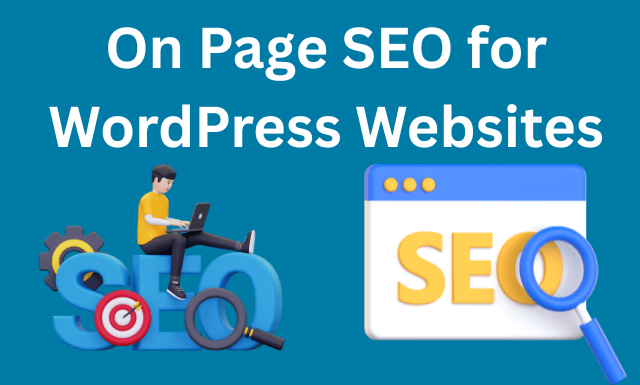In today’s digital landscape, having a beautiful WordPress website is only the first step to online success. Without visibility, even the most well-designed site can go unnoticed. This is where on page SEO for WordPress becomes essential. On-page SEO refers to the practice of optimizing individual web pages to rank higher and earn more relevant traffic in search engines. For WordPress users, mastering on-page SEO is not just a recommendation — it’s a necessity. This comprehensive guide will explore why on-page SEO is crucial for WordPress websites and how you can implement it effectively.
What is On Page SEO?
On page SEO involves optimizing both the content and HTML source code of a page. Unlike off-page SEO, which deals with external signals like backlinks, on-page SEO focuses on what you can control directly within your website. The key components include:
- Optimizing title tags and meta descriptions
- Using relevant keywords in content
- Structuring content with proper heading tags
- Internal linking
- Image optimization
- Improving site speed and mobile responsiveness
Why WordPress Websites Need On Page SEO
WordPress powers over 40% of all websites on the internet, making it the most popular content management system. However, its popularity also means fierce competition. Here are the top reasons why on page SEO for WordPress is critical:

1. Increased Organic Traffic
On-page SEO ensures your content is optimized for relevant search queries. With the right optimization techniques, your WordPress site can attract more organic traffic from users actively searching for your products or services.
2. Better User Experience
Search engines prioritize websites that offer a great user experience. On-page SEO helps structure your content in a way that is easy to read, navigate, and interact with. This results in lower bounce rates and higher engagement.
3. Improved Crawlability and Indexing
Search engine bots crawl and index websites to understand their content. On-page SEO practices like XML sitemaps, internal linking, and clean URLs help these bots navigate your site efficiently, ensuring your pages get indexed faster.
4. Enhanced Content Relevance
By targeting specific keywords and optimizing your content around user intent, on-page SEO improves the relevance of your content. This increases the chances of ranking higher for those targeted keywords.
5. Mobile Optimization
With Google’s mobile-first indexing, it’s crucial that your WordPress website is mobile-friendly. On-page SEO involves responsive design, optimized images, and fast loading speeds, all of which contribute to a better mobile experience.
Key Elements of On Page SEO for WordPress
1. Title Tags and Meta Descriptions
Your title tag is one of the most important on-page SEO elements. It should include your primary keyword and be enticing enough to encourage clicks.
Tips:
- Keep it under 60 characters
- Include your main keyword: on page SEO for WordPress
- Use action words or numbers to increase CTR
The meta description should be a concise summary of the page content, also including the keyword.
2. URL Structure
Clean, descriptive URLs help both users and search engines understand what the page is about.
Example: www.example.com/on-page-seo-for-wordpress
Avoid using random strings or numbers. Use hyphens to separate words and keep it short and keyword-focused.
3. Heading Tags (H1-H6)
Proper use of heading tags not only structures your content but also signals its importance to search engines.
- Use one H1 per page
- Include the keyword in the H1: Why We Need On Page SEO for WordPress Websites
- Use H2s and H3s for subheadings to maintain hierarchy and readability
4. Keyword Optimization
Use your focus keyword and related terms naturally within the content. Avoid keyword stuffing.
Best practices:
- Use the main keyword in the first 100 words
- Sprinkle LSI (Latent Semantic Indexing) keywords throughout
- Optimize for user intent
5. Image Optimization
Images enhance user engagement but can slow down your site if not optimized.
Checklist:
- Use descriptive file names
- Include ALT text with keywords
- Compress images for faster loading
- Use next-gen formats like WebP when possible
6. Internal Linking
Linking to other relevant pages on your site helps distribute link equity and keeps users engaged.
Examples:
- Link to your blog posts or service pages
- Use descriptive anchor text
- Avoid using “click here”
7. Mobile-Friendliness
A responsive design is crucial. Use themes that are mobile-optimized and test your pages with Google’s Mobile-Friendly Test.
8. Page Speed Optimization
Site speed is a ranking factor. Use caching plugins, optimize images, and minimize CSS and JavaScript files to enhance speed.
9. Schema Markup
Schema helps search engines understand your content better and can improve your click-through rates with rich snippets.
Use plugins like Schema Pro or Yoast SEO to implement structured data easily in WordPress.
10. Content Quality and Length
Content should be original, valuable, and comprehensive. Longer content tends to perform better in SERPs.
Content guidelines:
- Aim for 1,000+ words per post
- Use bullet points and images for better readability
- Update content regularly to keep it fresh
Recommended Plugins for On Page SEO in WordPress
1. Yoast SEO
One of the most popular SEO plugins, Yoast helps optimize meta tags, readability, and keyword usage.
2. Rank Math
A strong alternative to Yoast with more advanced features like built-in schema, keyword tracking, and analytics.
3. All in One SEO Pack
Another reliable plugin offering meta tag optimization, XML sitemaps, and social media integration.
4. WP Rocket
A powerful caching plugin that significantly improves page speed.
5. Smush
Compress and optimize images to improve load times without losing quality.
Common On Page SEO Mistakes to Avoid
- Keyword Stuffing: Overusing keywords can lead to penalties
- Ignoring Mobile Optimization: Most users are on mobile, so responsiveness is crucial
- Duplicate Content: Always create original content for each page
- Missing Alt Tags: ALT tags are crucial for image SEO
- Poor URL Structures: Use clean, keyword-rich URLs
How to Monitor Your On Page SEO Performance
Use these tools to track and improve your on-page SEO efforts:
- Google Search Console: Monitor indexing status, search traffic, and crawl errors
- Google Analytics: Understand user behavior and bounce rates
- Ahrefs/SEMrush: Track keyword rankings and SEO health
- Screaming Frog: Perform in-depth SEO audits
Final Thoughts: Make on page SEO for WordPress a Priority
On page SEO for WordPress is not a one-time task — it’s an ongoing process. By consistently optimizing your content, structure, and performance, you can improve your visibility in search results, drive more organic traffic, and achieve your online goals. Whether you’re a blogger, business owner, or developer, mastering on-page SEO is your ticket to long-term digital success.
Make it a habit to audit and optimize your WordPress site regularly. With the right tools, strategies, and dedication, you’ll see your rankings improve and your audience grow.
Contact me for SEO Consultation
